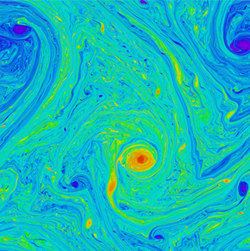Bounds on the energetics and entropy production of a buoyancy forced ocean
Duration: 32 mins 32 secs
Share this media item:
Embed this media item:
Embed this media item:
About this item

| Description: |
Winters, KB (UC, San Diego)
Friday 12 December 2008, 09:30-10:00 |
|---|
| Created: | 2009-01-16 11:21 | ||||
|---|---|---|---|---|---|
| Collection: | The Nature of High Reynolds Number Turbulence | ||||
| Publisher: | Isaac Newton Institute | ||||
| Copyright: | Winters, KB | ||||
| Language: | eng (English) | ||||
| Credits: |
|
||||
| Abstract: | We show that the volume averaged rate of entropy production in horizontal convection, i.e., $\chi \equiv \kappa < |{\nabla} b |^2 >$ where $b$ is the buoyancy, is bounded from above by $4.57 H^{-1} \kappa^{2/3} \nu^{-1/3} b_{\rm max}^{7/3}$. Here $H$ is the depth of the container, $\kappa$ is the molecular diffusion, $\nu$ the kinematic viscosity and $b_{\rm max}$ the maximum buoyancy difference prescribed on the surface. The rate of entropy production is directly related, via the volume integrated diapycnal buoyancy flux, to the energetics of irreversible mixing and the rate of energy transfer between available and background potential energy in the Boussinesq limit. The bound implies that the rate of generation of available potential energy by horizontal convection is no larger than $\kappa^{1/3}$ in the limit $\kappa \to 0$ at fixed $Pr=\nu/\kappa$. The bound on the energetics of mixing reinforces and strengthens the statement of Paparella and Young (2002) that horizontal convection is nonturbulent in limit of vanishing fluid viscosity and diffusivity. In the context of a model ocean, insulated at all boundaries except at the upper surface where the buoyancy is prescribed, the bounds on the energy transfer rates in the mechanical energy budget imply that buoyancy forcing alone is insufficient by at least three orders of magnitude to maintain observed or inferred average oceanic dissipation rates and that additional energy sources such as winds, tides or (perhaps) bioturbation are necessary to sustain nontrivial levels of turbulent dissipation and mixing in the world's oceans.
A seminar from the Rotating Stratified Turbulence and Turbulence in the Atmosphere and Oceans conference in association with the Newton Institute programme: The Nature of High Reynolds Number Turbulence www.newton.ac.uk/programmes/HRT/seminars/ |
|---|---|
Available Formats
| Format | Quality | Bitrate | Size | |||
|---|---|---|---|---|---|---|
| MPEG-4 Video | 480x360 | 1.83 Mbits/sec | 448.04 MB | View | Download | |
| WebM | 450x360 | 385.33 kbits/sec | 91.39 MB | View | Download | |
| Flash Video | 480x360 | 797.97 kbits/sec | 190.73 MB | View | Download | |
| iPod Video | 480x360 | 503.01 kbits/sec | 120.23 MB | View | Download | |
| QuickTime | 384x288 | 844.16 kbits/sec | 201.77 MB | View | Download | |
| MP3 | 44100 Hz | 125.04 kbits/sec | 29.52 MB | Listen | Download | |
| Windows Media Video | 474.19 kbits/sec | 113.34 MB | View | Download | ||
| Auto * | (Allows browser to choose a format it supports) | |||||

